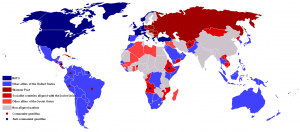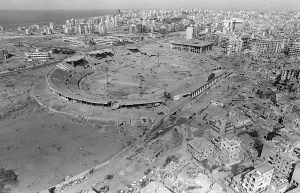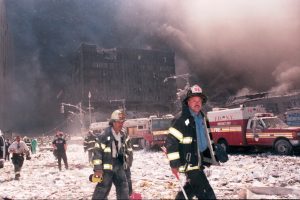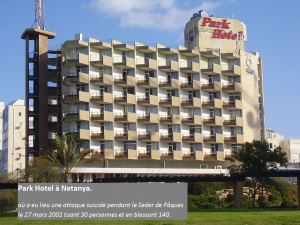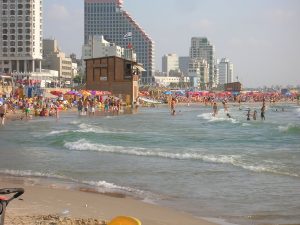
1990 AD to 2010 AD, Psalm 146: Asymmetric Wars
This site was first built in French (see www.147thgeneration.net). The English translation was mainly done using « google translation ». We have tried to correct the result of this translation to avoid interpretation errors. However, it is likely that there are unsatisfactory translations, do not hesitate to communicate them to us for correction.
(for that click on this paragraph)
Asymmetric Wars [1].
Summary
This generation of the 1990s and 2000s.
According to our count, this generation is the 146th generation associated with Psalm 146. It is in this Psalm 146 that we therefore find an illustration of the facts of this generation.
After the collapse of the former USSR, this generation begins with the First Gulf War, which seems to designate the United States as the one and only policeman in the world. A « new world order » appears to be taking hold.
The final victory of the coalition in Iraq and on the other hand the military supremacy of Israel pushes the Arab world to fight other than by conventional means. This generation sees the development of “asymmetric wars”.
Before this type of war comes to affect the USA, this new policeman of the world thinks he can “impose peace on the Middle East”, by multiplying initiatives and pressures on Israel during the first decade (1990-2000) of this generation.
Efforts in vain, especially since American hegemony was undermined on « September 11, 2001 ».
The direct effects of the terrorist attack are followed by the « economic effects of September 11 » which hit both the US and the world economy.
Israel, which refuses to give in to American pressure in the second decade (2000-2010) of this generation “takes its destiny back in hand”, and unlike other Western countries has a flourishing economy.
Economy which is also boosted by a new significant contribution due to a “new influx of Russian Jews”.
Talk
A new world order
At the end [2] of the twentieth century the United States of America is a superpower and the only one in the world, possessing the four criteria that define it: military force, economic development, technological innovation and cultural influence. (André Kaspi)
Thus on the eve of this generation (1990-2010), some believe that this American hegemony will finally conclude on an idealized and peaceful world.
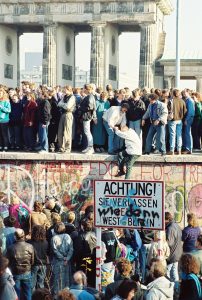
This power has been demonstrated since the collapse of the Soviet bloc at the beginning of this generation and then by the first Gulf War, which is the response to Iraq’s invasion of Kuwait in 1990. In the face of the US-led coalition , the fate of Saddam Hussein is no doubt.
George W. W. Bush, vice president under Reagan who becomes president of the United States in 1989 does not fully share this confidence. The end of USSR / US bipolarity does not necessarily guarantee a new stable global equilibrium. It can hide, on the contrary, a new world disorder:
- The end [3] of the cold war (1990) does not mean that of all dangers in the eyes of (George H. W.) Bush. It is no longer a sick and weakened USSR that is the main source of anxiety, but the disappearance of the bipolar system and the stability to which it has come to identify itself and the emergence of another more confused system. and still unexplored. His apprehension is all the more pronounced because, alone able to assume the charge of an international order he has invented, confronted with the many challenges that the end of the cold war tends to resurrect, victorious America does not seem to not herself in excellent health. Bush knows that he presides over the end of the old order, not the emergence of a new American order.
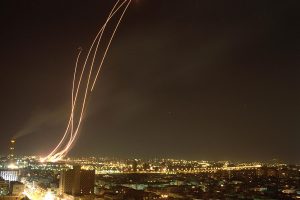
It may be in this context that before the war with Iraq began, the US still hoped, before the invasion of Kuwait, to be able to tame Saddam Hussein despite his violent anti-Israeli statements.
The defeat of Iraq at the beginning of this generation, rather than being a sign of a new order, is rather the trigger for a new type of North / South combat.
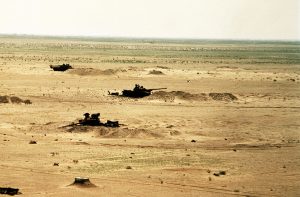
Weapons bought at a high price by Iraq from the West are of no use to those that the West has kept for its own use. The defeat is severe, and presumably hundreds of thousands of Iraqi soldiers died under coalition bombing without fighting. It is perhaps these deaths that prevented the armies of the coalition to go to Baghdad in 1991, thus avoiding exposing the carnage to public opinion. Faced with this finding of inefficiency of a « conventional » fight with the West, the temptation to fight it in an unconventional way becomes the option for the irreducible in the Arab world.
Asymmetric wars.
This generation sees a new type of conflict to replace conventional conflicts between armies in uniform. A new type of conflict where militarily disadvantaged belligerents arrogate to themselves the right to fight the designated enemy by all means at their disposal.


This generation is that of the emergence of asymmetric wars:
- In the Western democracies [4], during the pro-Palestinian protests of the winter of 2009, by an ordinary tragic paradox, we have heard the uttering of « anti-Zionist » slogans, demonizing and criminalizing by activists or admirers of Islamic-terrorist groups such as Hezbollah or Hamas. Groups that kill Israeli civilians, including women and children, and postulate that non-Muslims are inferior beings, humans to incomplete or deficient humanity. These « anti-Zionist » slogans, which are weapons, striking words, have the particular function of constructing and disseminating stereotypes, of attracting, of catching, of capturing the attention of the widest possible public, of rallying under the same banner convinced and undecided, and of course to mobilize against the enemy who is inhuman. Their main function is to justify the action against the designated enemies, reduced to « racists » and « assassins », to dehumanized humans against whom it is therefore lawful to appeal to all means of struggle.To put an end to the latest incarnations of the devil, it is allowed to resort to diabolical means, such as « human bombs ». These propaganda actions are part of a new type of war made possible by globalization: the so-called low-intensity war with unequal, asymmetrical weapons. In this type of war, characterized by the absence of a qualitative or quantitative symmetry between the belligerents, the weakest can stand up to the powerful. Asymmetric and boundless wars – in which the weakest do not refrain from resorting to any means – are notably led by terrorist groups who use the attacks not only as means of destabilizing the enemy, but also as instruments of propaganda. Countries like the United States or Israel, whose superiority is indisputable in terms of symmetrical combat, are now engaged in asymmetrical conflicts, to which they may seem insufficiently prepared, notably because of their ignorance of the new enemy, Islamist terrorism which resorts to « human bombs » and justifies them by a jihadist ideology based on promises of purity nourishing a re-Islamization of Islam.


Before the United States faced it in 2001, then Europe in the following years, Israel, rich in military victories over Arab neighbors, was its first victim. Israel is thus the first country to face an asymmetrical war after having shown its superiority in conventional wars:
- On December 8 [5], 1987, an Israeli driver caused a fatal accident in Gaza. The rumor of a deliberate murder spreads in the refugee camps and in a few days the uprising spreads across all the territories: it is the first intifada. Intifada led by representatives of the PLO leadership in Tunis (since the 1982 Lebanon war): urban guerrilla warfare. […]
- In 1988, the Intifada (« revolt of stones ») ignites this powder keg (Palestinian) while the recent conflict in Lebanon shows that an Arab-Israeli war remains a threat, despite the signing of peace with Egypt in 1979 .
Imposing peace in the middle east
At the beginning of this generation, America, rich in its new supremacy, tries to settle the Arab-Israeli conflict:
- On 30 September 1991 [6], the international conference on peace in the Middle East opens in Madrid, bringing together for the first time all parties (including Palestinians). It marks the beginning of the Israeli-Arab peace process, which will experience dramatic breakthroughs in the 1990s, as well as dramatic setbacks.
- The beginning of this process was made possible by the end of the ideological-strategic bipolarization between the United States and the Soviet Union that had deeply marked the region. The disappearance of the USSR put the United States, victorious from the Gulf War against Saddam Hussein (January-February 1991), in a position of diplomatic hegemony. It gave them the means to work for regional pacification that was now conceivable – the Arab states could no longer turn to the Soviet protector – and desirable. The resorption of local tensions is essential to sustainably establish the American leadership. The peace process thus launched allowed the start of bilateral negotiations in Israel between Israel and Syria, Lebanon, Jordan and a Palestinian delegation. […]
- The unblocking (following Yitzhak Shamir’s refusal to negotiate directly with the PLO) will follow, in June 1992, the victory of Labor led by Yitzhak Rabin, who will engage in early 1993 through Norway, direct talks with representatives of the PLO. They concluded successfully with the signing, on 13 September 1993, of the Declaration of Principles on Interim Self-Government Arrangements. The conclusion of such an agreement between two parties, who until then had been locked in the logic of mutual negation, constituted a turning point of the highest importance. […] For the PLO, hit by a serious institutional crisis after its alignment with Iraq, this « aggiornamento » gave him a second wind. […]
- Withdrawals and redeployments from the Israeli army led to the establishment of a Palestinian Authority with an elected president (Yasser Arafat until his death in 2004) and an elected legislative council. […] The Islamist movement (Hamas and Islamic Jihad) rejected the idea of a political compromise with Israel, against which violence remained the preferred option. In 1994, it used for the first time a new mode of action, the suicide bombing, with the aim of wavering the building of peace. On this objective the Muslim radicals were at the side of the Jewish « extremists ». The assassination of Prime Minister Rabin on November 4, 1995, by a Jewish fanatic, was fully in line with this logic. After its tragic death, followed a few weeks later by a violent Hamas attack campaign, the peace process will never again find its way back. The electoral victory in May 1996 of Benyamin Netanyahu, who had never made a secret of his hostility to the Oslo Accords, would mark a brutal stop to the peace process, which gradually stalled, despite the signing, under American pressure, of the Wye Plantation Agreement (October 1998).
America had previously tried to settle the Israeli-Palestinian conflict, following Israel’s invasion of Lebanon in 1982, imposing its views on its Israeli « ally »:
- In June 1982 [7], the Hebrew State invaded Lebanon (operation « peace in Galilee »). Soon, to prevent the situation from degenerating, the American administration is forced to become entangled in what will be a new « bee-eater ». On August 12, 1982, the President (Reagan) enjoined Begin to stop the « Holocaust » that West Beirut the Israelis would be perpetrating. Shortly after, he was forced to send, along with the French, soldiers to preserve the cease-fire whose tragedy of Sabra and Chatillah illustrates the fragility. At least, in the summer of 1982, is he in a position to advance a peace plan that addresses some of the concerns of his moderate Arab allies: complete autonomy for the Palestinians, which could be transformed into « self-government » in association with Jordanians.
And also following the first Gulf War:
- The (US) administration [8] is working to unblock an Arab-Israeli conflict that – war (from the Gulf of 1991) has reminded it – poses a permanent threat to peace. During the crisis, Saddam Hussein, who sought to mobilize Arab opinions in a holy war against the « infidels », did not fail to draw a parallel between the situation in Kuwait and that in the « occupied territories ».
- He even tried to involve Israel in the conflict by launching deadly raids on his Scuds rockets that the American Patriot systems intercepted, not in their entirety. After much effort to dissuade him, the Americans may have ended up resigning Israel to retaliate, when Tel-Aviv had the wisdom to give up so as not to drag Jordan into hostilities. This did not prevent, the war ended, Washington to denounce the policy of colonization of Tel-Aviv as the main obstacle to peace and, after a true diplomatic marathon, to succeed in launching in Madrid, October 30, 1991, a long and difficult series of talks.
The Oslo accords will not lead to the expected peace, they allow the return of Arafat from his exile who interprets the agreements in his own way:
- Rafiah [9], July 1994. The commander of the Israeli armed forces in Gaza, Lieutenant General Doron Almog, is awaiting the arrival of the convoy bringing Yasser Arafat back from Egypt. Something strange in the « Rais » position in his limousine draws his attention.Arafat who, thanks to the Oslo Accords, returns to Gaza, after an eclipse of twenty-six years, seems greater than in the memory of Almog … Later, the reason will be known: the seat of the president was raised to enable him to smuggle four illegal Palestinians into Israel who are barred from entering the Territories. Among them, Jihad Amarin, one of the veterans of the « Western Front », which served as a relay for the attacks of the PLO in the West Bank, and Mamdoukh Nofel, one of the organizers of the massacre of the schoolchildren of Maalot in 1974. Only the intervention of Prime Minister Yitzhak Rabin in the form of an ultimatum to Yasser Arafat leads to their expulsion from the territories (and with them four other Palestinians concealed in a second car of his convoy). They will come back to the territories a little later.

Until the late 1990s, hopes for peace were not transformed despite the efforts of the Americans, who put pressure on both sides to find an agreement. It is in particular Bill Clinton’s wish to wring an agreement before he gives way to his successor:
- A slowdown [10] in the peace process marks the years 1997-1999 despite some attempts like the Wye Plantation agreement in October 1998, which will never be implemented. […]

- On May 17, 1999, Labor Ehud Barak, who pledged to withdraw the Israeli army from southern Lebanon and resume negotiations, was elected prime minister. […] On May 24, 2000, Israel withdrew from South Lebanon but in the camp of the Hezbollah’s irreducible, who take control of almost the entire security zone, the Israeli attitude is interpreted as an admission of weakness to enjoy.
- Bill Clinton, however, wishes to mark the end of his term by signing a historic peace agreement in the Middle East. Between July 11 and 25, 2000, he convened an Israeli-Palestinian summit at Camp David, the very place where President Carter managed to seal the groundwork for the Israel-Egypt agreement in 1978. (….)

- At the end of September, while the Israeli-Palestinian talks are still deadlocked, Ariel Sharon’s visit to the Temple Mount in Jerusalem is the trigger for the second intifada. […]
- At the instigation of President Clinton, Palestinians and Israelis begin in Taba on January 21, 2001, new negotiations to make every effort to reach a real agreement within ten days, before election time.
Also:
- The purpose of the Clinton Platform [11] is to speed up negotiations to reach an agreement before the change of power in the United States (January 20, 2001) and elections in Israel (February 6), or least, leave an « inheritance » to the following governments, both in Washington and in Jerusalem. The Israeli-Palestinian round begins on Tuesday, December 19 (2000), based on the US Air Force Bolling, near Washington. […]
- On Saturday, Clinton brings the two delegations together and introduces them to the platform. Its general principles are: blocks of settlements will remain in place – home to 80% of the settlers – against an exchange of territories between the parties, in which Palestinians will receive, within the « green line », land equivalent to 1 and 3% of West Bank territories; the Palestinian state will cover 94 to 96 percent of the West Bank; sharing of sovereignty in Jerusalem (Arab neighborhoods to Palestinians, Jews to Israel) and in the old city (the Jewish quarter and, perhaps, the Armenian quarter, to Israel) and on the Temple Mount (the western wall to Israel, mosques with authority and a kind of « functional sovereignty » with regard to the underground space); […] the signing of this agreement will mean the end of the conflict. Clinton demands a quick response for Wednesday, December 27th.
- The ultimatum expired, Israel accepts the platform. […] Arafat unlike Barak, delays his answer, asks Clinton several clarifications and, in fact, responds in the negative. […] On January 1, Clinton demands that Arafat come to the White House with an answer.
- The day after his meeting at the White House, Arafat accepts the platform with his own amendments and demands clarification on the right of return of refugees and sovereignty over the Western Wall as well as improvements in the exchange of territories . […] Clinton and (Dennis) Ross come to the conclusion – which they tell the new administration – that Arafat does not want an agreement to end the conflict and that in fact he has always played with America.

- On 21 January, the day after the transfer of power (Clinton / Bush) powers in the United States (and a couple of weeks before the elections in Israel), the Israeli and Palestinian delegations meet at the Hilton Hotel in Taba in order to a last effort to advance the negotiation. […] After seven days the discussions end without agreement.
These negotiations do not allow the conclusion of the second intifada. Neither the Mitchell Report nor the Tennet Plan put an end to hostilities with even bloodier attacks such as the « Dolphinarium » in June 2011:
- On April 30 (2001) [12], the conclusions of the commission led by Senator George Mitchell, following the Sharm el-Sheikh summit in October 2000, are published. Its role is to investigate the circumstances that led to the explosion of the conflict and to suggest measures to stop the continuation of the violence. One of the main conclusions is that « there is no basis for the (Israeli) assertion that the Palestinian Authority had a plan to provoke a wave of violence, but there is no evidence that the The Authority had tried to calm the Palestinian demonstrations or to curb the violence. In this report, we read that the « visit of Sharon (on the Temple Mount on September 20, 2000) did not provoke the Al Aqsa Intifada, » but « his moment was untimely and his provocative effect should have been taken. beforehand « . […]
- (the commission demands concessions from Israel and a greater effort by the Authority towards terrorism, despite semi-accepting half-hearted, the violence does not stop)
- (Friday, June 1, 2001) bursts the most serious incident since the beginning of the confrontation, which tests the restraint policy decreed (10 days ago) by Sharon. A Hamas activist blew himself up at the entrance to the « Pacha » discotheque at Tel-Aviv’s « Dolphinarium ». Twenty-one teenagers, mostly children from immigrant families in the Soviet Union are killed. More than eighty wounded. […]
- (Contrary to expectations, Israel is not retaliating against this attack and extending the unilateral cease-fire that is being consolidated by CIA chief George Tennet)
- On Wednesday 13 June at 3 pm, Sharon and Arafat, each on their own, proclaim the ceasefire and acceptance of the Tennet plan. (….) Beyond Arafat’s public appeal and some discussions, there is no Palestinian effort to stop the fire. […]
- The Tennet plan suffers from the same weakness as the Mitchell plan. It does not provide for outside control to determine which side is violating the ceasefire and to impose sanctions against the offender.


- The « World Conference against Racism, Racial Discrimination, Xenophobia and All Forms of Intolerance » [13] was the occasion of nine days of heated debate, following the call by some Arab countries for to restore UN General Assembly Resolution 3379 of 10 November 1975, revoked after the Madrid Conference of 1991, which, in addition to calls for self-determination of peoples and against apartheid in South Africa, condemned « the impious alliance between South African racism and Zionism » and described him as « racist ».
- At the beginning of the conference, its president, Kofi Annan announces that it excludes any reference to Zionism. The next day, the United States and Israel delegations leave the conference on 3 September. France and the other countries of the European Union threaten to do the same if Zionism is assimilated to racism. A final declaration against racism is voted, snatch. This statement is condemned by Australia and Canada, who denounce the « hypocrisy » of the conference that did not serve the resolution of the Israeli-Palestinian conflict. The latter, above all, sought, according to the Canadian delegate, « to delegitimize the State of Israel and to dishonor its history and the suffering of the Jewish people ».
- Finally, the 58th point of Durban’s final report stated that « We recall that the Holocaust must never be forgotten », the 61st point criticized the « rise of anti-Semitism and Islamophobia in various parts of the world », while that the 63rd point affirmed:
- « We are concerned about the plight of the Palestinian people living under foreign occupation. We recognize the inalienable right of the Palestinian people to self-determination and the establishment of an independent State, as well as the right to security of all States in the region, including Israel, and call upon all States to support the process peace and bring it to a successful conclusion « .
The conference closes September 9, 2001 …
September 11th
A few days before September 11, America still thinks itself invincible. Since the early 1990s, Americans may think they have become the police of the world. The feeling of invincibility of the USA is such after the explosion of the Soviet bloc and the first Gulf War, that filmmakers see danger only in unconventional enemies; Thus the threats faced by heroes in the movies of the 1990s are the machines (Terminator 2 in 1991 or Matrix in 1999), the aliens (Men in Black in 1997 or Independence Day in 1996), the mutants (X-Men in 2000 ) or the universe (Armageddon in 1998). No human enemies capable of questioning American hegemony …
Bill Clinton’s speech in January 2000 illustrates this tranquility:
- « We [14] have, » he says, « the chance to live at this moment in history. Never before has our nation benefited from so much prosperity and social progress with so few internal crises and so few external threats … «
When George Bush is elected, the US economy after years of strong growth slows down with a growth rate of 2.2% of GDP [16], the lowest level since 1996.
On September 11, 2001, America wakes up and comes out of its dream of undisputed hegemony over the world …
The first American Airlines plane hit the North Tower of the World Trade Center at 8:46. Accident or attack, the Americans tend rather for the accident.
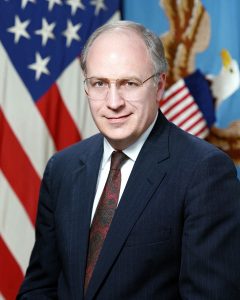
The second plane, that of United Airlines, in turn hit the South Tower of the World Trade Center at 9:03. At the White House, Dick Cheney understands that America is under attack. No accident, it is an attack. Help is still struggling for nearly two hours, not always with consultation, until hope disappears into the dust:
- (9:58) In [17] the Air Force One conference room, what the presidential staff picks up on the TV set seems apocalyptic. A snippet of report, caught between two operations, speaks of horror. People would have jumped skyscrapers, others still cling to the edge of the void … Suddenly appears on the screen an unimaginable scene: one of the towers of the World Trade Center … collapse. George Bush looks, petrified. […]
- (10:00) In New York, the floors of the south tower fell on top of each other, the building vanished in a deluge of fire. Around, people start running, terrified. A monstrous mass of debris and ashes rush into the streets, plunging them into darkness. […]
- (10:28) On Air Force One television screens, the picture is apocalyptic: the second tower of the World Trade Center is collapsing in turn. The President watches, paralyzed, the south of Manhattan disappear in a cloud of ashes and fumes.
On the morning of September 11, America realizes that war, a new type of war, can reach it on its soil:
- On September 11th [18], terror descends on the United States, which is undergoing the greatest attack since Pearl Harbor. It causes panic and dread, followed by a psychotic effect, the fear of being targeted all over the world and on their own soil. […] This is an attack conceived, organized, planned methodically to strike at the heart the greatest power in the world. […] The common goal of these simultaneous attacks (World Trade Center, Pentagon, and attempt on the Capitol) was to challenge at the same time in all its political, economic, financial and military components the world supremacy of the United States. […]
- A few days after the attack on the World Trade Center towers, the financial heart of New York is ready to restart. […] But the attacks undermined the principles of liberal financial orthodoxy by placing the state at the heart of the emergency system, as in times of war. While the US economy was already losing steam ahead of the bombing and was under threat of a recession, governments are intervening to maintain the confidence of consumers and businesses.
The psalm of this generation (2010 – 2030) sums up perfectly the seventh war of Israel, the one against an enemy without an army, followed by the terrorist attack against the supposed gendarme of the world:

- Hallelujah! My soul, praise the Lord.
- I shall praise the Lord in my life; I shall sing to the Lord as long as I exist.
- Do not trust in princes, in the son of men, who has no salvation.
During the first half of this generation (the 1990s), Israel relied on nations to seek peace. The Oslo Accords were followed by the Mitchell Report, the Tennet Plan and countless other actions for which Israel has even accepted concessions on Jerusalem. These proved to be sterile and only brought more terrorism.


- His spirit leaves, he returns to his soil; on that day, his thoughts are lost.
Americans who wanted, through the obtaining of peace in the Middle East, to become unquestionably the policemen of a new world. The dust (he returns to his soil) of the World Trade Center towers annihilated these hopes (his thoughts are lost) on September 11, 2001 (on that day).
September 11 is not a simple terrorist attack, it marks a new phase in the world putting down the hopes for universal peace after the Second World War:
- On September 11 [19], this event, which has no name as the vocabulary is powerless to describe it, resembles Auschwitz; it escapes the general good sense, the fundamental values of humanity, the common contract of civilizations. That day, a new reality entered our lives, those of murderers without borders eager to die to kill. That day, a new totalitarianism, Islamic fundamentalism, brought us back to the dark days of criminal and frustrated devotees. That day, a new form of war broke out, without battle front, without army, nothing to negotiate, and especially not peace. That day, the world has changed, and no doubt also our idea of man and the future. In this agonizing new world, we have all lost some of our sense of security, and perhaps a little carelessness and freedom.
To put September 11 at the same level as Auschwitz is inappropriate, but it is obvious that Islamism and Nazism have points in common. For the Nazis, there were three types of men, the Aryans and among the others, the sub-men, those who could continue to live in a status close to the slave and those who did not have the right to live. Among these, the Jews. The world is for the Aryans without sharing.
For the Islamists, there are also three categories of men, the believers, and among the others, the disbelievers, and the dhimmis. The dhimmis are « protected » because attached to a lawful religion, a protection that allows them to live but also in a status close to the slave. The disbelievers who do not adhere to a lawful religion do not have the right to live. For the benefit of the Islamists, a disbeliever may decide to be a believer and have the same rights, including the right to live, as other believers. For the Nazis, one can not become Aryan – especially for Jews -.
Of course, one should not confuse Islamist and Muslim, both read the same book the Koran. The difference is that Islamists favor warlike verses and Muslims, for those who accept cohabitation with other religions, prefer to rely on peaceful verses.
In 1930, few Germans were Nazis, the Germans did not fight, for the great majority, Nazism. The consequence was that all Germans became Nazis, voluntarily or passively.
The risk is the same for Islam, if Muslims do not fight Islamists, they will all become Islamists by adhesion or passively. Moreover behind the passivity, there can be opportunism: when the Germans let themselves be engulfed by Nazism, they would have greatly benefited from a victory of the latter by becoming the masters of a new world. The same trick can seduce many Muslims who unconsciously could be seduced by a triumphant Islam.
The economic effects of September 11
The September 11 attack makes President Bush gain unexpected popularity in the United States. In the process, the United States attack the Taliban in Afghanistan and decide to attack Saddam Hussein’s Iraq and seemingly win. We know today that these victories have been ephemeral. The United States is still trying to be the world’s gendarmes but without any real success. Before 9/11, the US economy had already shown some fragility; in 1987, for the first time since 1917, America returned to a net debtor status abroad. This fragile situation is aggravated with September 11th.
The American economic response is consistent with the real trap set by Al Qaida:
- For Americans [20], the real danger is to let the attacks and the chain reaction they triggered lead to the effect that bin Laden, precisely, hopes to draw: « All we have to do, will explain the latter in a 2004 video message, is to send two mujahideen … (and) to brandish a piece of cloth with « al-Qaeda » written on it to make sure his generals rush and inflict upon America casualties , economic and political. However, the administration seems strangely rushing into the obvious trap where the terrorist leader wants to attract him.
The first worrying signs are noticeable soon:
- The United States [21], shaken by the shock of September 11, know from the beginning of 2002 a wave of scandals of great magnitude that reveal the dysfunctions of the US financial system. The failure of American energy broker Enron, the fifth largest American company, is, by its magnitude, the largest ever recorded in the United States. It will be exceeded a few months later by that of WorldCom, the second US long-distance operator. More business collapses follow.
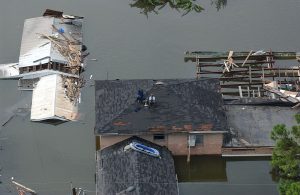
During a natural disaster, the United States, like the USSR with Chernobyl a generation before, definitely demonstrate that they are no longer the masters of the world:
- On Monday, August 29, 2005 [22], Hurricane Katrina strikes southern Louisiana. […] The relief arrived late, the human losses are high and the material damage considerable. […] At the political level, the catastrophe reveals that the United States, first power of the world, are forced to accept the help of other countries and they come out of it humiliated, because nothing had been planned by the administration to help the poor, or to help them quickly.
In fact, the violent American efforts to boost the economy in the aftermath of September 11 are causing enormous speculation with cheap money being introduced into the economy. At first, like any speculative bubble, it artificially creates unexpected growth in the United States and around the world. But the awakening will be difficult: the subprime crisis produces a crisis comparable to the Great Depression of 1929 plunging the world into a serious recession. This crisis will be amplified by the sovereign debt crisis. The terrorists of September 11 have achieved their goals.
Israel takes control of its destiny
September 11 loosens the hands of the Israelis. The Palestinian street had already clumsily sided with the terrorists:
- September 11, 12:14 pm [23]: Statements of support continue to arrive in Washington. Chinese President Jiang Zemin has assured George Bush of his sympathy and strongly condemns « all forms of terrorist violence ». But not everyone is in unison. The ABC channel diffuses disturbing images: in East Jerusalem, young Palestinians are dancing with joy to the cries of « Allah is great! », A woman makes the V of the victory, one hears youyous of joy …
Contrary to the logic of the attacks, the USA takes their distance with Israel in order to preserve their alliances in the Arab world. They are trying to force the Israelis into forced peace and unjustified concessions. Israel then has the courage to say « no » to the USA to take its destiny in hand, thus listening to the psalmist’s advice to this generation, « Do not trust in princes, in the son of men, who has no salvation« :
- (Following 11 September) Arafat’s assurances [24] prompt Bush to think that the President of the Authority is « in the same boat » as America and that he can trust him in the fight against terrorism. In reverse, an unexpected tension develops between the American president and Ariel Sharon. The two men are talking on the phone shortly after the attacks on New York, and, on the recommendation of one of his advisers, Bush decides that it is an opportunity or never to pressure Sharon to renew negotiations with the Palestinian Authority. Sharon refuses and becomes, in his own right, the first leader in the world to say « no » to Bush after 9/11. This negative response provokes a temporary tension between the two countries and reinforces the position of a group of the Administration in favor of a line of criticism towards Israel. These men accept some of the complaints of the Arab world, for whom the eternal support of the United States for Israel has caused American troubles with the Arabs and led to Bin Laden’s hitting them. In the following weeks, the Americans embark on a dual campaign: an operation in Afghanistan (starting October 7, 2001) and the « reactivation » of a Bush administration plan for the Middle East that includes the support for a Palestinian state.
Also:
- From the spring of 2002 [25], the United States appears to be increasingly aligned with Tel Aviv. This is a criticism that the Bush Administration had already addressed shortly after coming to power. She had shown a complete understanding of the Israeli incursions into areas yet recognized by the Palestinian Authority, granting the IDF the right « to enter and exit » from these territories, but not to « reoccupy » them. So much so that in the summer of 2001 the crown prince of Saudi Arabia, a country to which the Bush were closely linked, sent an unambiguous message to Washington: their two countries would no doubt have gone their separate ways. Alarmed, Bush had decided to give the Arabs a pledge of goodwill: shortly after the attacks, he had publicly declared in favor of the creation of a state called Palestine, which none of his predecessors had done.
The asymmetrical warfare imposed on Israel is not intended solely to kill or indiscriminately wound civilians. Like the September 11 attack on the United States, it also aims to weaken Israel economically:
- Many [26] Palestinians view suicide attacks as a strategic weapon aimed at restoring the balance of deterrence against Israel. The prevailing logic is simple: « Anything that damages Israel is to our advantage, » says Hamas leader Sheikh Hassan Youssef. « Of course, this has negative effects on Palestinian society, but the damage inflicted on the Israelis is even more important from our point of view: economically, they suffer a huge fall and losses in billions of dollars. One million Israelis now need public assistance. At the psychological level, we managed to get Israelis afraid in their homes and cities. «
The intensification of the attacks makes Israel react. Especially after the particularly bloody attack that affects a group of Jews in full seder (meal) Pesach (Easter).
At the cost of major efforts and an engagement of the army in the heart of Palestinian terrorist centers, Israel ends up gaining the upper hand over the asymmetrical war imposed on it:


- In the first half of 2004 [27] the security forces appear to be an impressive success in their fight against terrorist networks in the West Bank […]. Despite the floods of money and directives of the Lebanese Hezbollah, Israel manages to thwart nearly 95% of attempted attacks. […]

- Terrorism, according to the leader of the Aman, General Aharon Zeevi-Farkash, is decreasing to an « almost tolerable » level. The change is reflected in the attitude of the Israeli population. Cafes and restaurants are filling up again, while bus tours are no longer a risky bet. « Terrorism is a bottomless barrel, » says Deputy Chief of Staff General Ashkenazi. « It never stops, especially when a whole people is moved by a national cause ». But we have achieved a radical change: Basically, our citizens can rest easy. Israeli society is facing terrorism, and it was not easy two years ago. Israelis are indeed learning to live with terrorism, […] the public is ignoring and devoting themselves to everyday life. Life « resumes its course »: the radio and television channels continue to broadcast advertisements, even entertainment programs, even the days of attacks. The economy is recovering, thanks to the improvement of the security situation and the recovery of the global economy.
The Oslo accords had already allowed Israel’s first economic boom at the beginning of this generation.
The control of terrorism allows Israel to have an economy that is recovering largely in the last years of this generation of the years 1990-2010. The Israeli economy is much more resilient to the subprime crisis than most Western countries. Israel, a country in scarcely should, as its enemies had hoped, enter an economic slump, which would have been almost fatal. On the contrary, to this generation, Israel produces more wealth than it consumes:
- Since its creation [28] until the mid-1990s, the State of Israel has bought much more abroad than it could sell. Thus, the deficit in the balance of goods and services in Israel rose from $ 222 million in 1949 to $ 10.1 billion in 1996. In relative terms, however, the deficit declined as the young state developed its economy. In 1950, Israeli exports financed only 12.5% of imports. In 1960, this figure had risen to 51 per cent, and reached 79 per cent in 1996. At that time, the trade deficit actually began to decline, from $ 4.7 billion in 2001 to $ 0.7 billion in 2005. In 2006, the balance of goods and services was, for the first time, positive, reaching $ 0.9 billion. […]

- Israel’s debt increased until 1995 to reach $ 20.8 billion. It has since declined to zero in 2002. In 2005, Israel had net worth of $ 23.2 billion. […] Sixty years after its independence, Israel has become a country whose GDP per capita (in purchasing power parity) is roughly equivalent to that of France or Taiwan. The industrial development of this unique country is even more surprising if one takes into account the poverty of the soil resources and the hostility of the neighboring countries.
The psalmist can therefore in the continuation of the psalm of this generation, as he does in the previous psalms associated with the return to sovereignty of the Jews on their earth, to thank the divine providence which allows Israel to conquer and prosper at the same time:

- Praiseworthy is he in whose help is the God of Jacob; his hope is in the Lord his God.
- Who made heaven and earth, the sea and all that is in them, Who keeps truth forever.
- Who performs justice for the oppressed, Who gives bread to the hungry; …
New influx of Russian Jews
The refuzniks had already flocked to Israel to the previous generation. The fall of the USSR causes massive emigration of Russian Jews to Israel to this generation of the 1990s, participating in the economic boom of the country:
- In 1988 [29], the PLO changed course and proclaimed in Algiers its desire to create an independent Palestinian state in the occupied territories, alongside – and not in place of – the Israeli state. Unofficial official first contacts are opening up in several European capitals between Israeli and Palestinian personalities. Hindered for a brief moment by the first Gulf War (summer 1990-winter 1991), the way was thus marked at the conference of Madrid (October 30, 1991), then with the agreements of Oslo (September 13, 1993) between Israelis and Palestinians , while hundreds of thousands of Soviet Jews flock to Israel from 1989.

- The numbers are considerable: half a million immigrants between 1989 and 1994, and one million until the end of the decade. A demographic surplus equivalent to 20% of the total population of the country, of a very high socio-cultural level, and the opposite of the wave of Ethiopian immigrants (Falashas or Beta Israel) arrived, during the 1980s and 1990s, to the outcome of Operation « Solomon », named after the love of the great biblical monarch and the Queen of Sheba. In 2009, they numbered one hundred thousand.
- By its wealth and its very high intellectual level, Soviet emigration had a spectacular effect on Israeli society: nearly 80,000 engineers, scientific researchers and architects, 16,000 doctors and dentists, 18,000 nurses, 16,000 writers, artists and musicians whose integration has been relatively fast, in a period of great economic change as a result of the computer revolution.
It is this contribution that is mentioned at the end of the psalm of this generation, the Russian Jews « prisoners » of the USSR are released (the Lord sets loose the bound). The terms « the Lord straightens the bent » as used in the Psalm of the previous generation completes the qualification. The concluding psalm on a eulogy of the divine:

- … the Lord sets loose the bound.
- The Lord gives sight to the blind; the Lord straightens the bent; the Lord loves the righteous.
- The Lord guards the strangers; He strengthens the orphan and the widow, and He perverts the way of the wicked.
- The Lord will reign forever! Your God, O Zion, to all generations. Hallelujah!

In the end of the psalm, the psalmist evokes the « wicked« . It is true that this generation culminates anti-Zionist and anti-Semitic attacks. Thus, more and more, it is perversely assimilated between Zionism and Nazism, artificially transforming the victim into an executioner. While a reasoned analysis of the facts shows that the Israeli army without being angelic does its best to avoid the civilian casualties doing for it taking further risks to its soldiers. Anti-Semitism is resurfacing even in Europe, which has just buried the Holocaust. This generation has seen in addition to the irrational condemnation of Israel by almost all nations, as exemplified by the Durban Conference, a resurgence of anti-Semitism in the world including Europe or this one. was unthinkable a few years ago after the Nazi adventure.

[1] According to Pierre-André Taguieff: « The new anti-Jewish propaganda (French Title: « La nouvelle propagande antijuive »). Introduction. Pierre André Taguieff relies on: Enyo: Anatomy of a disaster (in French: « Anatomie d’un désastre »).
[2] Serge Berstein / Pierre Milza: « History of the 20th century, volume 4, 1990 to the present day (French: « Histoire du XXe siècle, tome 4, 1990 à nos jours ». (p.77)).
[3] Pierre Melandri: « History of the United States, II – The Decline? (since 1974) « . (French: « Histoire des Etats-Unis, II – Le Déclin ? (depuis 1974) ». (p. 213) ).
[4] Pierre-André Taguieff: « The new anti-Jewish propaganda ». Introduction. (French: « La nouvelle propagande antijuive ». Introduction. (p. 3,4).)
[5] Anne Grynberg: « Towards the land of Israel ». (French: « Vers la terre d’Israël ». (p. 119, 120) )
[6] (Collective work of: Antoine Germa / Benjamin Lellouch / Evelyne Patlagean): « The Jews in history ». Alain Dieckhoff’s chapter: « Israel in its regional and international environment ». (presentation limited to 2006). (French: « Les Juifs dans l’histoire ». Chapitre de Alain Dieckhoff: « Israël dans son environnement régional et international ». (exposé limité à 2006). (p.651 à 653). )
[7] Pierre Melandri: « History of the United States, II – The Decline? (since 1974) « . (French: « Histoire des Etats-Unis, II – Le Déclin ? (depuis 1974) ». (p. 161) )
[8] Pierre Melandri: « History of the United States, II – The Decline? (since 1974) « . (French: « Histoire des Etats-Unis, II – Le Déclin ? (depuis 1974) ». (p. 221) )
[9] Amos Harel, Avi Isacharoff, French translation by Jean-Luc Allouche: « The seventh war of Israel ». Chapter: « A war without a declaration ». (p.51) (French: « La septième guerre d’Israël ». Chapitre : « Une guerre sans déclaration ». (p. 51) )
[10] Anne Grynberg: « Towards the land of Israel ». (French: « Vers la terre d’Israël ». (p. 122 to 124) )
[11] Amos Harel, Avi Isacharoff, translated by Jean-Luc Allouche: « The seventh war of Israel ». Chapter: « A war without a declaration ». (French: « La septième guerre d’Israël ». Chapitre : « Une guerre sans déclaration ». (p. 127 à 130) )
[12] Amos Harel, Avi Isacharoff, translated by Jean-Luc Allouche: « The seventh war of Israel ». Chapter: « A war without a declaration ». (French: « La septième guerre d’Israël ». Chapitre : « Une guerre sans déclaration ». (p. 58 à 164) )
[13] From : http://fr.wikipedia.org/wiki/Conférence_de_Durban
[14] Pierre Melandri: « History of the United States, II – The Decline? (since 1974) « . (French: « Histoire des Etats-Unis, II – Le Déclin ? (depuis 1974) ». (p. 230) )
[16] Data: Serge Berstein / Pierre Milza: « History of the 20th century, volume 4, 1990 to the present day ». (French: « Histoire du XXe siècle, tome 4, 1990 à nos jours ». (p.83) )
[17] Nicole Bacharan, Dominique Simonnet: « September 11, the day of chaos ». Foreword. (French: « 11 septembre, le jour du chaos ». Avant-propos. (p. 171 à 192) )
[18] Serge Berstein / Pierre Milza: « History of the 20th century, volume 4, 1990 to the present day (French: « Histoire du XXe siècle, tome 4, 1990 à nos jours ». (p.83 à 86)).
[19] Nicole Bacharan, Dominique Simonnet: « September 11, the day of chaos ». Foreword. (French: « 11 septembre, le jour du chaos ». Avant-propos. (p. 12) )
[20] Pierre Melandri: « History of the United States, II – The Decline? (since 1974) « . (French: « Histoire des Etats-Unis, II – Le Déclin ? (depuis 1974) ». (p. 467) )
[21] Serge Berstein / Pierre Milza: « History of the 20th century, volume 4, 1990 to the present day (French: « Histoire du XXe siècle, tome 4, 1990 à nos jours ». (p.89)).
[22] Serge Berstein / Pierre Milza: « History of the 20th century, volume 4, 1990 to the present day (French: « Histoire du XXe siècle, tome 4, 1990 à nos jours ». (p.99)).
[23] Nicole Bacharan, Dominique Simonnet: « September 11, the day of chaos ». (French: « 11 septembre, le jour du chaos ». (p. 216) )
[24] Amos Harel, Avi Isacharoff, translated by Jean-Luc Allouche: « The seventh war of Israel ». Chapter: « A war without a declaration ». (French: « La septième guerre d’Israël ». Chapitre : « Une guerre sans déclaration ». (p. 210,211) )
[25] Pierre Melandri: « History of the United States, II – The Decline? (since 1974) « . (French: « Histoire des Etats-Unis, II – Le Déclin ? (depuis 1974) ». (p. 468) )
[26] Amos Harel, Avi Isacharoff, translated by Jean-Luc Allouche: « The seventh war of Israel ». Chapter: « A war without a declaration ». (French: « La septième guerre d’Israël ». Chapitre : « Une guerre sans déclaration ». (p.176,177) )
[27] Amos Harel, Avi Isacharoff, translated by Jean-Luc Allouche: « The seventh war of Israel ». Chapter: « To the evacuation« . (French: « La septième guerre d’Israël ». Chapitre : « Vers l’évacuation ». (p.415 à 417) )
[28] (sous la direction d’)Alain Dieckhoff : « L’Etat d’Israël ». Chapitre : « Une économie sur la voie de l’indépendance ». (p. 233,234) et Chapitre : « La nouvelle économie israélienne ». (p. 243)
[29] Michel Abitbol : « Histoire des Juifs, de la genèse à nos jours ». (p. 645, 646)


